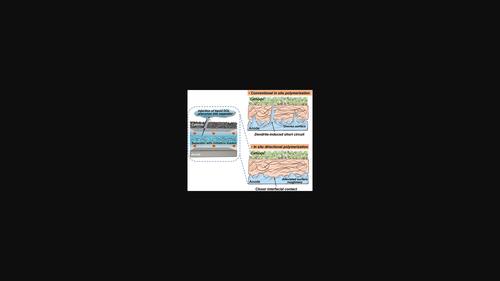当前位置:
X-MOL 学术
›
Energy Environ. Mater.
›
论文详情
Our official English website, www.x-mol.net, welcomes your
feedback! (Note: you will need to create a separate account there.)
In Situ Directional Polymerization of Poly(1,3-dioxolane) Solid Electrolyte Induced by Cellulose Paper-Based Composite Separator for Lithium Metal Batteries
Energy & Environmental Materials ( IF 13.0 ) Pub Date : 2022-02-24 , DOI: 10.1002/eem2.12370 Jian Ma 1 , Yueyue Wu 1 , Hao Jiang 1 , Xin Yao 1 , Fan Zhang 1 , Xianglong Hou 1 , Xuyong Feng 1 , Hongfa Xiang 1
Energy & Environmental Materials ( IF 13.0 ) Pub Date : 2022-02-24 , DOI: 10.1002/eem2.12370 Jian Ma 1 , Yueyue Wu 1 , Hao Jiang 1 , Xin Yao 1 , Fan Zhang 1 , Xianglong Hou 1 , Xuyong Feng 1 , Hongfa Xiang 1
Affiliation

|
In traditional in situ polymerization preparation for solid-state electrolytes, initiators are directly added to the liquid precursor. In this article, a novel cellulose paper-based composite separator is fabricated, which employs alumina as the inorganic reinforcing material and is loaded with polymerization initiator aluminum trifluoromethanesulfonate. Based upon this, a separator-induced in situ directional polymerization technique is demonstrated, and the extra addition of initiators into liquid precursors is no longer required. The polymerization starts from the surface and interior of the separator and extends outward with the gradually dissolving of initiators into the precursor. Compared with its traditional counterpart, the separator-induced poly(1,3-dioxolane) electrolyte shows improved interfacial contact as well as appropriately mitigated polymerization rate, which are conducive to practical applications. Electrochemical measurement results show that the prepared poly(1,3-dioxolane) solid electrolyte possesses an oxidation potential up to 4.4 V and a high Li+ transference number of 0.72. After 1000 cycles at 2 C rate (340 mA g−1), the assembled Li||LiFePO4 solid battery possesses a 106.8 mAh g−1 discharge capacity retention and 83.5% capacity retention ratio, with high average Coulombic efficiency of 99.5% achieved. Our work may provide new ideas for the design and application of in situ polymerization technique for solid electrolytes and solid batteries.
中文翻译:

用于锂金属电池的纤维素纸基复合隔膜诱导的聚(1,3-二氧戊环)固体电解质的原位定向聚合
在固态电解质的传统原位聚合制备中,引发剂直接添加到液态前驱体中。本文以氧化铝为无机增强材料,负载聚合引发剂三氟甲磺酸铝,制备了一种新型纤维素纸基复合隔膜。在此基础上,证明了分离器诱导的原位定向聚合技术,并且不再需要在液体前体中额外添加引发剂。聚合反应从隔膜的表面和内部开始,随着引发剂逐渐溶解到前体中而向外延伸。与其传统对应物相比,隔膜诱导的聚(1,3-二氧戊环)电解质显示出改善的界面接触以及适当减缓的聚合速率,这有利于实际应用。电化学测量结果表明,制备的聚(1,3-二氧戊环)固体电解质具有高达 4.4 V 的氧化电位和高 Li+转移数为 0.72。在2 C倍率(340 mA g -1)下循环1000次后,组装的Li||LiFePO 4固体电池具有106.8 mAh g -1的放电容量保持率和83.5%的容量保持率,平均库仑效率高达99.5% . 我们的工作可能为固体电解质和固体电池原位聚合技术的设计和应用提供新的思路。
更新日期:2022-02-24
中文翻译:

用于锂金属电池的纤维素纸基复合隔膜诱导的聚(1,3-二氧戊环)固体电解质的原位定向聚合
在固态电解质的传统原位聚合制备中,引发剂直接添加到液态前驱体中。本文以氧化铝为无机增强材料,负载聚合引发剂三氟甲磺酸铝,制备了一种新型纤维素纸基复合隔膜。在此基础上,证明了分离器诱导的原位定向聚合技术,并且不再需要在液体前体中额外添加引发剂。聚合反应从隔膜的表面和内部开始,随着引发剂逐渐溶解到前体中而向外延伸。与其传统对应物相比,隔膜诱导的聚(1,3-二氧戊环)电解质显示出改善的界面接触以及适当减缓的聚合速率,这有利于实际应用。电化学测量结果表明,制备的聚(1,3-二氧戊环)固体电解质具有高达 4.4 V 的氧化电位和高 Li+转移数为 0.72。在2 C倍率(340 mA g -1)下循环1000次后,组装的Li||LiFePO 4固体电池具有106.8 mAh g -1的放电容量保持率和83.5%的容量保持率,平均库仑效率高达99.5% . 我们的工作可能为固体电解质和固体电池原位聚合技术的设计和应用提供新的思路。


















































 京公网安备 11010802027423号
京公网安备 11010802027423号